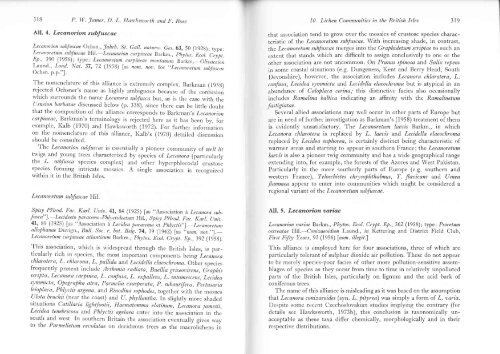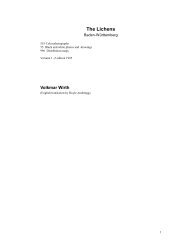Lichen communities in the British Isles: A preliminary conspectus
Lichen communities in the British Isles: A preliminary conspectus
Lichen communities in the British Isles: A preliminary conspectus
Create successful ePaper yourself
Turn your PDF publications into a flip-book with our unique Google optimized e-Paper software.
318 P. W. James, D. L. Hawksworth and tr'. Rose 10. <strong>Lichen</strong> Communities <strong>in</strong> <strong>the</strong> <strong>British</strong> <strong>Isles</strong> 319<br />
AlI. 4. Lecanorion subfuscae<br />
Lecanoyio Gall. naturzo. Ges. 63,50 (192g); type:<br />
Leca nore !<br />
Ep., 3eo ";;:Ht"',,::;*;'J:,f;t:gr#:,i":,<br />
Laund., Lond" Nat.37,72 (1958) fas nom. noa. for "Lecanoretum subfuscae<br />
Ochsn. p.p."].<br />
The nomenclature of this alliance is extremely complex. Barkman (19-5g)<br />
rejected ochsner's name as highly ambiguous beca..,se of <strong>the</strong> confirsion<br />
which surrounds <strong>the</strong> name Lecanora suhfusca but, as is <strong>the</strong> case with <strong>the</strong><br />
(Jsneion barbatae discussed below (p. 338), s<strong>in</strong>ce <strong>the</strong>re can be little cloubt<br />
that <strong>the</strong> composition of <strong>the</strong> alliancc corresponds to Barkm an,s Lecanorion<br />
carp<strong>in</strong>eae, Barkman's. term<strong>in</strong>ology is rejected here as it has been by, for<br />
example, Kalb (1970) and Hawksworth (1972). For fur<strong>the</strong>r <strong>in</strong>formation<br />
on <strong>the</strong> nomenclature of this alliance, I{alb's (1970) detailed cliscussion<br />
should be consulted.<br />
The Lecanorion suhfuscae is essentially a pioneer community of vtell lit<br />
twigs-and -young trees characterized- by .pecies of Lecanora (particurarly<br />
<strong>the</strong> ,r- ' sybfusca species complex) and o<strong>the</strong>r hyperphloeociar crrrstos"<br />
species form<strong>in</strong>g <strong>in</strong>tricate mosaics. A s<strong>in</strong>gle ,..o.<strong>in</strong>iion is recog'ized<br />
with<strong>in</strong> it <strong>in</strong> <strong>the</strong> <strong>British</strong> <strong>Isles</strong>.<br />
Le c anor etum subfus c a e HiL<br />
spisy Pfirod. Fac. Karl. (Jnizt.4!,8+ (lgzs) fas "Associationh. Lecanora sub-<br />
fttsc a"f .-Lecideelo par as emo-Phly ctideetum Htl-., spisy piirod. F ac. Karl. u nizt.<br />
41, 89 (7925) fas "Association ir Lecidea paraserni et phlyctis,'1. Lecanoretum.<br />
allophanae Duvign., Bull. soc. r. bot. Berg. 74, 39 (lg+zi lns :'no*. noz.t.',1.-<br />
Lecanoretum carp<strong>in</strong>eae atlanticum Barkm., phytos. niot iryl>t. 8p.,392 (195g).<br />
This association, which is u'idespread through <strong>the</strong> <strong>British</strong> <strong>Isles</strong>, is particularly<br />
rich <strong>in</strong> species, <strong>the</strong> most important components beirg Lecaiora<br />
chlarotera, L. chlorona, L. pattida and Lecitlella elieochoma. otiler species<br />
frequently present <strong>in</strong>clude Arthonia radiata, Buellia griseo,irens, Graphis<br />
scripta, Lecanora carp<strong>in</strong>ea, L. confusa, L. expallens, L.-<strong>in</strong>tumesceni, Lecidea<br />
qtmmicta, opegrapha atra, Parmelia exasperata, p. nrbaurifera, pertusaria<br />
leioplaca, Pllyctis argena, and R<strong>in</strong>od<strong>in</strong>a soprtodes, toge<strong>the</strong>r *ith'tn. mosses<br />
Lllota bruchii (near <strong>the</strong> coast) and u. ph1,ilantha. In slightly more shaclecl<br />
situations catillaria lightfootii, Haematomma elat<strong>in</strong>uml Le'canrra jamesii,<br />
Lecidea tenebricosa and Phlyctis agelaea enter <strong>in</strong>to <strong>the</strong> association <strong>in</strong> <strong>the</strong><br />
south and west. In sou<strong>the</strong>rn Brita<strong>in</strong> <strong>the</strong> association eventually gives .w,ay<br />
to <strong>the</strong> Parmelietum rexolwtae on dcciduous trees as <strong>the</strong> maciolichens <strong>in</strong><br />
that association tend to grow over <strong>the</strong> mosaics of crustose species characteristic<br />
of <strong>the</strong> Lecanoretum subfuscae. With <strong>in</strong>creas<strong>in</strong>g shade, <strong>in</strong> contrast,<br />
<strong>the</strong> Lecanoretum wbfuscae merges <strong>in</strong>to <strong>the</strong> Graphidetum scriptae to such an<br />
extent that stands which are difficult to assign conclusively to one or <strong>the</strong><br />
o<strong>the</strong>r association are not uncommon. On Prunus sp<strong>in</strong>osa and Salix repens<br />
<strong>in</strong> some coastal situations (e.g. Dungeness, Kent and Berry Head, South<br />
Devonshire), however, <strong>the</strong> association <strong>in</strong>cludes Lecanora chlaratera, L.<br />
confusa, Lecidea symmicta and Lecidella elaeochroma but is atypical <strong>in</strong> an<br />
abundance of Caloplaca cer<strong>in</strong>a; this dist<strong>in</strong>ctive facies also occasionally<br />
<strong>in</strong>cludes Ramal<strong>in</strong>a baltica <strong>in</strong>dicat<strong>in</strong>g an aff<strong>in</strong>ity with <strong>the</strong> Ramal<strong>in</strong>etum<br />
fastigiatae.<br />
Several allied associations may well occur <strong>in</strong> o<strong>the</strong>r parts of Europe but<br />
are <strong>in</strong> need of fur<strong>the</strong>r <strong>in</strong>vestigation as Barkman's (1958) treatment of <strong>the</strong>m<br />
is evidently unsatisfactory. The Lecanoretum laez:is Barkm., <strong>in</strong> which<br />
Lecanora chlarotet'a is replaced by L. laez,is and Lecidella elaeochroma<br />
replaced by Lecidea euphorea, is certa<strong>in</strong>ly dist<strong>in</strong>ct be<strong>in</strong>g characteristic of<br />
warmer areas and start<strong>in</strong>g to appear <strong>in</strong> sou<strong>the</strong>rn France; <strong>the</strong> Lecanoretum<br />
laexis is also a pioneer twig community and has a wide geographical range<br />
extend<strong>in</strong>g <strong>in</strong>to, for example, <strong>the</strong> forests of <strong>the</strong> Azores and West Pakistan.<br />
Particularly <strong>in</strong> <strong>the</strong> more sou<strong>the</strong>rly parts of Europe (e.g. sou<strong>the</strong>rn and<br />
western France), Teloschistes chrysophthalmxts, T. faxicans and (Jsnea<br />
fammea appear to enter <strong>in</strong>to <strong>communities</strong> which might be considered a<br />
re gional variant of <strong>the</strong> L e c anor e tum s ubfu s c ae.<br />
All. 5. Lecanorion aariae<br />
Lecanorion tariae Barkm., Phytos. Ecol. Crypt" Ep.,362 (1958); type: Psoretum<br />
ostreatae Hil.--Conizaeoidion Laund., <strong>in</strong> Ketter<strong>in</strong>g and District Field Club,<br />
First Fifty Years,92 (1956) lnom. illegit.l<br />
This alliance is employed here for four associations, three of which are<br />
particularly tolerant of sulphur dioxide air pollution. These do not appear<br />
to be merely species-poor facies of o<strong>the</strong>r more pollution-sensitive assemblages<br />
of species as <strong>the</strong>y occur from time to time <strong>in</strong> relatively unpolluted<br />
parts of <strong>the</strong> <strong>British</strong> <strong>Isles</strong>, particularly on lignun and <strong>the</strong> acid bark of<br />
coniferous trees.<br />
The name of this alliance is nrislead<strong>in</strong>g as it was based on <strong>the</strong> assumption<br />
that Lecanora conizaeoides (syn. L. pityrea) was simply a form of L. aaria.<br />
Despite some recent Czechoslovakian studies imply<strong>in</strong>g <strong>the</strong> contrary (for<br />
details see Hawksworth, 1973b), thrs conclusion is taxonomically unacceptable<br />
as <strong>the</strong>se taxa differ chemically, morphologically and <strong>in</strong> <strong>the</strong>ir<br />
respective distributions.





